-

人教版高中英语必修3Festivals around the World说课稿3篇
Teaching plan for Unit 1 book3Good morning, teachers. It’s my great pleasure to be here because I can share my lesson with you and I can learn a lot from it. I’ll begin my lesson from the following four parts, the teaching material, the teaching methods, the studying methods and the teaching procedure.Firstly, let me talk about the teaching material. The content of my lesson is the reading passage festivals and celebrations of Unit 1 Festivals around the world. This passage is about festivals and celebrations. By studying this passage, we’ll enable the students to know that festivals exit everywhere, and many of festivals in different countries celebrate similar ideas. As we all know, the reading passage is the center of each unit. If the Ss can learn it well, it will be helpful to make the Ss learn the rest of this unit.After studying the teaching material, I think the teaching aims are as the followings:1. Knowledge aims:(1) The Ss can master the usage of the important words andexpressions.(2)The Ss can use the __________________ (grammar) in the proper situation.Make students know about the festivals all over the world and the detail of the festivals, such as origin, content, and the date of the holiday festivals.2. Ability aims:(1) Students can talk about festivals and celebrations in English(2) To improve the student’s reading ability, especially their skimming and scanning ability.3. Emotion aims:Make the Ss know about the foreign festivals, and respect other countries’ custom.Next, let’s come to the important points and the difficult points.The important point is how to make the Ss understand the text better and the difficult point is how can they talk about it. secondly, Teaching Methods:1. task-based Language Teaching2. Computer assisted language teaching.3. question-and–answer methodThirdly, Studying Methods:

人教版高中英语必修4Theme parks说课稿3篇
The oldest and the most popular park in the worldenjoy the exciting activities thereget close to the life-size cartoon characters like Mickey Mouse and Donald Duck Step 3 Pre-reading1.What do you suppose a theme park is ?2.What do you think you can see in a theme park?(1.It is a kind of amusement park which has a certain theme – that the whole park is based on. 2.buildings, castles, statues, rare animals and birds, and so on.) Step 4 Reading ----- Theme Parks –---- Fun and More Than Fun1.Predict : Read the title and the pictures on P. 34 and PredictWhat is the meaning of the title “Theme Park – Fun and more than fun”?(The title means that theme parks are fun to visit, but that they can also be educational and can offer useful information.)2.Skimming Fast read and answer:What activities can we take in a theme park?Amusement park: Bumper car Merry-go-round slide bungee jumping Free-fall rides Horror films Pirate ship Ferris wheel roller coaster3.Scanning Read again and you will find various theme parks are mentioned in the passage . Then what are they ?Theme parks: Sports theme park History theme park Culture theme park Marine or Ocean theme Park Future park Science theme park Disneyland4.Careful reading and find the main idea of each paragraph:THEME PARKS---- entertaining/ educationalPara.1 Traditional parks are places to go for relaxation and to have time away from our busy lives.Para.2 Theme parks are different They’re large and full of things to do, see and buy.Para.3 Theme parks are built around a single idea or theme. One example is a sports park.Para.4 Another kind of theme park is historical more and cultural and can be educational.Para.5 Disneylandwas the first theme park. It is based on the fantasy life and characters of Disney’s films.Para.6 Some examples of educational theme parks include sea world parks and science parks.

人教版高中英语必修3Healthy Eating说课稿4篇
Language learning needs a context, which can help the learners to understand the language and then can product comprehensible output, so computer has the advantages to make the materials attractive.Part 3 Learning MethodsTask-based, self-dependent and cooperative learningPart 4 Teaching ProcedureStep One Lead-in“Interest is the best teacher.” Therefore, at the very beginning of the class, I should spark the students’ mind to focus on the centre topic “the band”. I’ll show some pictures of food to attract their attention and then bring some questions.Question:What kind of food they like?What should go into a good meal?The answers must relate to the diet. After this, the students will be eager to know something about a balance diet and this is the very time to naturally lead the class into Step 2Step 2 Reading for information: skimming and scanning In this step, I use Task-based Language Teaching method, which can give students a clear and specific purpose while skimming and scanning the context.Task 1 General ideaThe students will be asked to just glance at the title and the pictures of the passage, and then guess what they will read in the text. And they’ll be divided into groups of four to have a discussion.The purpose is to inspire the students to read actively, not passively. In addition, the task is to develop the students’ reading skill by making prediction and to encourage the students to express their thoughts in English and cooperate with each other.Task 2 Main idea of each paragraphCooperative learning can raise the students’ interest and create an atmosphere of achievement. Based on this theory, I divide the whole class into 4 groups to skim the whole text and get the main idea of each paragraph.

人教版高中英语必修4Working The Land说课稿3篇
Knowledge objectives:(1) to make Ss grasp the usage of words, expressions and sentence structures: statistics, struggle, thanks to, rid of, some patterns for persuasion, the “ing” form as subject and object;(2)to use learnt knowledge to persuade sb.Ability objectives:(1) to develop Ss’ reading skills(skimming, scanning, word guessing);(2) to improve Ss’ speaking, communicating and cooperating skills.Emotional objectives:to make Ss know the contribution of Yuan,and learn his spirit and his simple life time.Teaching important and difficult points:(1) some words, expressions and sentence structures mentioned above;(2)the content of the text;(3)training their reading and speaking skills.Teaching methods: CLT, TBLT,QT.Learning strategies: CLS, QLS, TBLS.Teaching procedures:Step 1 lead-in: (1) teacher plays a piece of recent news from CCTV about the harvest of the super hybrid rice, and ask students whether they know Yuan or not, and talk about him and his contribution.(2)Brain storm: let Ss describe Yuan in their minds including his appearance, his living condition and so on.Step 2 fast reading tasks:(1)teacher introduces Yuan and super hybrid rice(2)make Ss read the text as fast as possible with questions. Such as: what’s the general ideaof this passage? What’s Yuan’ dream? (skimming and scanning skill)Step 3 intensive reading tasks(1)let Ss read the text silently, find topic sentence of each paragraph and draw the difficult sentences and the knowledge what they don’t understand.(words guessing)(2)teacher and Ss talk about the important words, expressions and sentences together, and ask Ss to retell the content of the text.(summarizing and paraphrasing)(3)teacher summarize this part.(4) read again following the courseware.

人教版高中英语必修3The million pound bank note说课稿3篇
在接下来的细读环节,我套用了高考对阅读理解的考查方式设置了5个问题,分别为三个推理判断题,一个细节题和一个主旨大意题。学生需要对文章的内容进行分析、归纳、推理、猜测等高级思维活动才能做出正确的回答。【设计意图】这一过程是对学生进行细读的训练,培养学生获取特定信息和挖掘文章深层次信息的能力。第三环节:Intensive-reading (精读) 15′第三个环节精读,既是最重要的环节,也是突破本课重难点的关键。首先,让学生思考剧本中人物看到百万英镑前后的态度发生了怎样的变化。其次,让学生仔细阅读文章,找出可以表现人物态度变化的具体的语言和动作。最后,让学生总结人物的态度发生变化的根本原因是什么,从而引出Money Talks, 供学生思考。【设计意图】通过一系列的活动培养学生学习从人物的语言和动作探究人物的心理,使学生进一步体会戏剧语言的魅力,从而对文章背后所反映的社会问题进行思考,也为下一步的讨论环节做好铺垫。

人教版高中英语必修5First aid说课稿6篇
In this class, I have 3 teaching aims, that is, knowledge aims, ability aims and emotion aims.1) Knowledge-Teach students new words and expressions, such as temporary, bleed,sprain choke, first aid, fall ill and so on.-Enable students to have a better understanding for some basic knowledge of first aid.2) Ability-Train students’ speaking, reading and writing abilities by different teaching activities, such as skimming, comprehending, team work, role play, retelling and writing.-Develop students’ reading strategy on how to move general idea to specific information.3) Emotion-Promote students’ awareness of giving first aid.- Cultivate students’ creativities.Then let’s come to my teaching methods and activities.III. Teaching methods and activities:To achieve different teaching aims, various kinds of teaching methods and activities will be adopted throughout this period, such as TBL (task-based learning), skimming, team work, brainstorm and others, which can offer students opportunities to fulfill tasks in which they can use language to achieve a specific outcome.IV. Teaching aids:Computer and blackboardV. Teaching important points:1) Make students have a clear mind for the structure of the text.2) Help students understand the theme of the text.VI. Teaching difficulties:1) So many new words may affect students’ understanding.2) How to get students to know about the functions of the skin and thecauses, characteristics and treatments for different degree burns,and the knowledge about giving first aid. VII. Blackboard design:

人教版高中英语必修5Great scientists说课稿4篇
通过写文章梗概,培养学生综合运用语言的能力,学习用恰当的英语描述科学家的故事。这是本课的教学难点。教师可以使用完形填空的方式来帮助学生整理语篇,从而来降低难度。本课的教学重点的突破方法是:在阅读前,让学生初步了解得出科学观点所需要的基本程序,从而轻松而自然地导入文章的阅读;在阅读过程中,由易到难设计快速阅读和精读的问题,层层推进各种阅读活动,让学生对阅读内容从整体感知到细节理解,最后深层读懂整篇文章,同时加强阅读策略的指导,让每个学生都主动参与课堂教学活动,最终达到提高阅读能力的目的。Step 4 Post-readingGroup Activities四人小组共同合作,在老师的适当指导下,就以下2个问题展开讨论,让学生就所知、所学、所感和所想融入话题,然后抽若干同学代表作小组发言。1. What do you think about John Snow, and what should we learn from him?2. Cholera was 19th century disease, which two diseases are similar to cholera today? Why?

人教版高中英语必修5Life in the Future说课稿5篇
Good afternoon, everyone. It’s my great pleasure to be here sharing my lesson with you. The content of my lesson is Senior English for China Book5 Unit 3 Life in the Future. I’ll be ready to begin this lesson from six parts: Analysis of the teaching material, Analysis of the students, Teaching aims and important and difficult points, Teaching methods and aids, Teaching procedures, and Blackboard design. First, let me talk about the teaching material.Part 1 Analysis of the Teaching Material:This unit is about what human beings’ life will be like in about one thousand years. By studying of this unit, we’ll Enable the students to know the changes in humans’ life and some new inventions bringing about the change and develop the interest in science. This lesson plays an important part in the English teaching in this unit. This is an important lesson in Book Five. From this lesson, it starts asking the Ss to grasp contents of each passage. Therefore, this lesson is in the important position of the teaching material. If the Ss can learn it well, it will be helpful to make the Ss learn the rest of this unit.Part 2 Analysis of the SsAs Senior2 Ss, they are at different levels of English fluency, some of them have lost interest in English. So during the lesson, I arrange a variety of activities to let all of them join in to attract their interest and let them be confident and taste the joy of success.

人教版高中英语必修5Making the news说课稿4篇
今天我们来介绍一下必修五第四单元的授课方式。这个单元的题目是Making the news。应该是学生比较感兴趣的话题,学生往往对新闻工作充满好奇,所以我们可以利用这个机会多设计一些师生互动和学生互动,来激发起学习的积极性,提高学习效率。同时我们可以利用这个单元不仅帮助学生掌握语言知识,培养语言能力,同时让其了解新闻工作的重要性,培养起社会智能感。这个单元分为六个课时,它的教学目标是这样的:语言目标是掌握词汇表中的常用单词和短语,掌握倒装句的一些基本用法。 技能目标是能初步掌握约会的基本句型并在真实的场景下正确运用。新闻报道类文章的写作技能。采访的基本规范和沟通技能。情感目标是对新闻报道的客观性和真实性有更好的理解。对新闻记者的职业有更深入的了解,并能体会其工作的重要性。下面我们来介绍一下第一课时的授课方式,第一课的教学目标是这样的第一课时的教学目标语言目标:单词:Occupation, journalist, editor, photographer, curious, personality, enthusiasm

人教版高中英语必修5The United Kingdom说课稿4篇
Teaching Aims:Knowledge 1. Get the students to learn the useful new words and expressions in this section. Aims:2. Let the students learn about how the UK was formed and the four groups of invaders.1. Develop students’ reading ability and let them learn different Ability reading skills. Aims:2. Enable students to learn to talk about the United Kingdom and the Union Jack Emotional 1. Let students know more about the UK2. Develop students’ sense of cooperative learning Aims:Teaching Important Points:1. Let the students learn about the countries of the United Kingdom and the Union Jack2. Get the students to read the passage and know about how the UK was formed and the four groups of invaders.3. Have the students learn different reading skills.Teaching Difficult Ponts:1. Develop students’ reading ability.2. Enable students to talk about the United Kingdom and the Union Jack.3. Let students learn how the UK was formed geographically and historically.Teaching Methods:Showing pictures, asking, exercising, listening, reading etc.Teaching Aids:A computer,a projector and a blackboard.Teaching Procedures: 1) Show a map of the world, ask students the following questions:Where is the UK?What’s the full name of the UK?2) Ask the students work in pairs to do the quiz on Page 9.Do you want to test how many things you know about the United Kingdom? Let’s have a small test.Using the map on P9, students answer the following questions:?How many countries does the UK consist of? What are they??England is divided into three main areas. Do you know what they are? 1) Scanning (10Minutes )Let the students hold the questions asked in pre-reading and read the passagequickly and then let them do the following exercise.Join lines to the right answer.
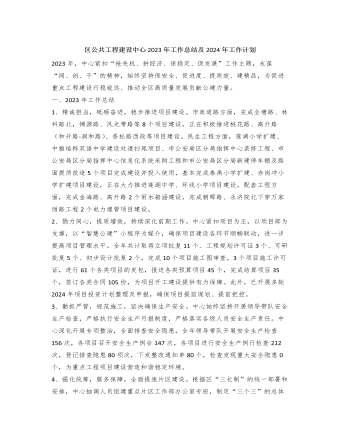
区公共工程建设中心2023年工作总结及2024年工作计划
(四)持续激发片区活力,开创新局面。一是进一步坚持目标导向。结合片区特色亮点,紧扣片区定位和重大项目布局,聚力攻坚片区主导方向,全力配合片区搞好基础设施建设。二是进一步压实工作责任。立足重点片区工作实际,全面梳理“四考”(新增项目、新增入库、土地出让、集中开工)“三单”(基础设施建设清单、产业项目帮扶清单、招商引资项目清单),进一步完善考评细则,以年终绩效考核为抓手压实目标责任,以考核见真章,以考核促实效,充分激发十大重点片区比学赶超、奋勇争先的干劲。三是进一步强化协调调度。坚持目标导向与问题导向相统一,主动跟踪服务,对重点片区道路建设、招商引资、土地出让、流程审批、控规修编等方面存在的问题,分层级有序调度,逐个项目研究、逐个问题破解,稳步推进,推动项目早落地、早开工、早投产、早入库、早增效。志之所趋,无远弗届;志之所向,无坚不入。站在新的起点上,我们将保持发展定力,增强自身能力,坚定凝心聚力谋发展的决心不动摇,乘势而上开新局,砥砺奋进开新篇,为全面建设全国一流现代化强区,奋力谱写中国式现代化的我区篇章贡献更大公建力量。
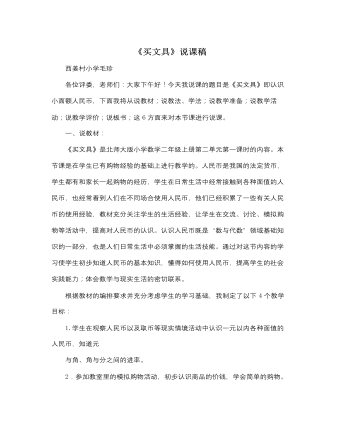
北师大版小学数学二年级上册《买文具》说课稿
(一)、情境导入通过播放笑笑和淘气在文具店购买文具活动的视频片段,唤起学生已有的知识和经验,使学生想到“买东西要使用人民币”。又因为二年级孩子年龄较小,社会经验不足,上市场、超市购物的机会也少,对人民币只是初步的认识,对于要用到钱才能买到东西这一朴素的等价交换的原则只有初步的意识。所以借此机会激发学生想不想和笑笑、淘气一起到文具店里去购买文具呢?从而引出课题:买文具。(二)、认识小面额人民币学生在生活中经常看到人民币,有时还使用人民币,因此我首先让学生互相交流:你知道有哪些面值的人民币?根据学生的回答,老师有序地进行板书:1角、2角、5甬1元、2元、5元10元、20元、50元100元在这一环节中我仅作为引导者,引导学生相互交流,在师生互动中完成对已有知识经验的归纳与延伸,通过小组合作,互相交流,让全体学生参与学习过程,在学习过程中有意识培养学生细心观察、仔细倾听、善于总结的良好习惯。
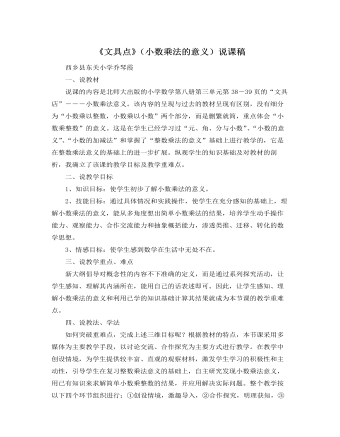
北师大版小学数学三年级上册《文具点》说课稿
(三)深化运用,巩固新知在这个环节,我设计四组闯关题。第一关是试一试:①买3支铅笔需要多少元?②买两把直尺需要多少元?这关是模仿性练习,让学生运用已学的数学知识解决实际问题。第二关是说一说,在学生初步感知了小数乘法的意义后,我给出了6个算式,让学生说一说他们所表示的意义。第三关是填一填,即根据加法算式写乘法算式和根据乘法算式写加法算式,这两关是提高性练习。第四关是涂一涂,即根据算式涂涂得出结果。是为了进一步加深学生对小数乘法意义的理解。第五关是想一想:0.3×4=0.6,4×0.3=?这关是深化性练习,一是让学生明白整数乘法的交换律在小数乘法中同样适用,二是让学生体会一个整数乘小数的意义也是求几个几是多少。第六关是两组口算练习。第七关是两道解决问题。主要是在学生理解小数乘整数的意义的基础上复习以前所学的数量关系。
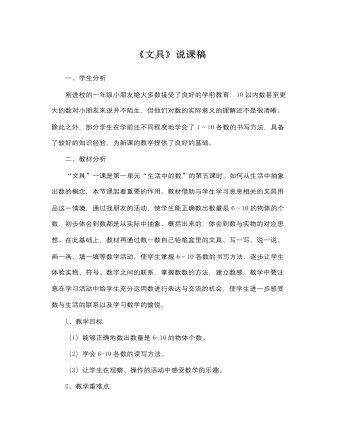
北师大版小学数学一年级上册《文具》说课稿
一、学生分析刚进校的一年级小朋友绝大多数接受了良好的学前教育,10以内数甚至更大的数对小朋友来说并不陌生,但他们对数的实际意义的理解还不是很清晰。除此之外,部分学生在学前还不同程度地学会了1~10各数的书写方法,具备了较好的知识经验,为新课的教学提供了良好的基础。二、教材分析“文具”一课是第一单元“生活中的数”的第五课时。如何从生活中抽象出数的概念,本节课起着重要的作用。教材借助与学生学习息息相关的文具用品这一情境,通过找朋友的活动,使学生能正确数出数量是6~10的物体的个数,初步体会到数都是从实际中抽象、概括出来的,体会到数与实物的对应思想。在此基础上,教材再通过数一数自己铅笔盒里的文具、写一写、说一说、画一画、填一填等数学活动,使学生掌握6~10各数的书写方法,逐步让学生体验实物、符号、数字之间的联系,掌握数数的方法,建立数感。
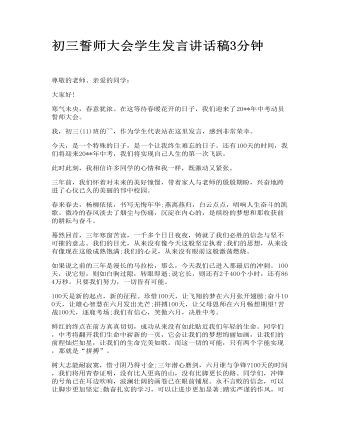
初三誓师大会学生发言讲话稿3分钟
三年前,我们怀着对未来的美好憧憬,带着家人与老师的殷殷期盼,兴奋地跨进了心仪已久的美丽的邗中校园。春来春去,杨柳依依,书写无悔年华;燕离燕归,白云点点,唱响人生奋斗的凯歌。微冷的春风淡去了烟尘与伤痛,沉淀在内心的,是缤纷的梦想和那收获前的耕耘与奋斗。蓦然回首,三年寒窗苦读,一千多个日日夜夜,铸就了我们必胜的信念与坚不可摧的意志。我们的目光,从来没有像今天这般坚定执着;我们的思想,从来没有像现在这般成熟饱满;我们的心灵,从来没有眼前这般激荡燃烧。

中班语言教案:趣味识动字—跳、爬、吹、打
2、激发幼儿学习兴趣,积极参与游戏活动。准备:多媒体课件(跳、爬、吹、打四个字);骰子一个;打、吹的物品;会爬动物的头饰(如虫、蜗牛);圈; 过程:一:看动画识字上次我们去动物园,看到了很多动物,还看到了海狮和大象为我们表演的节目,小朋友,觉得怎么样啊?有些小动物今天来到幼儿园,还要为我们表演节目,我们来看看它们是谁。 A:(1)图上是谁?它在干什么?我们来学学小公鸡吹喇叭吧!(2)小公鸡还带来一个字宝宝,认识一下吧,这是“吹”宝宝,请“吹”宝宝也表演一个节目。(3)还有什么东西也可以吹呢?是用什么吹的?“吹”宝宝的身上有什么?
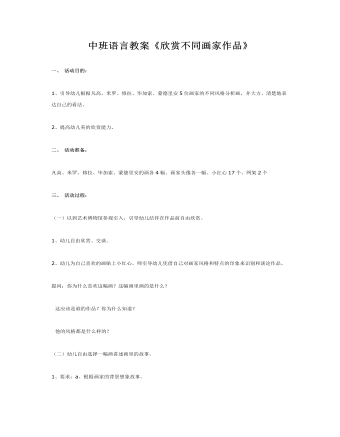
中班语言教案《欣赏不同画家作品》
2、提高幼儿美的欣赏能力。二、活动准备:凡高、米罗、修拉、毕加索、蒙德里安的画各4幅、画家头像各一幅、小红心17个、网架2个三、活动过程:(一)以到艺术博物馆参观引入,引导幼儿结伴在作品前自由欣赏。1、幼儿自由欣赏、交谈。2、幼儿为自己喜欢的画贴上小红心。师引导幼儿凭借自己对画家风格和特点的印象来
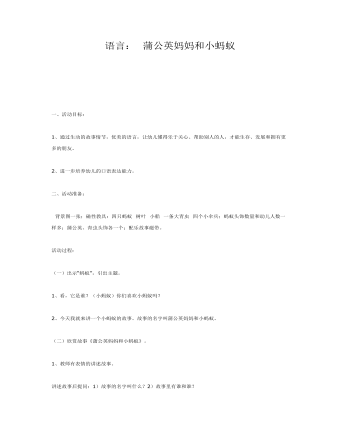
中班语言课件教案: 蒲公英妈妈和小蚂蚁
2、进一步培养幼儿的口语表达能力。二、活动准备: 背景图一张;磁性教具:四只蚂蚁 树叶 小船 一条大青虫 四个小伞兵;蚂蚁头饰数量和幼儿人数一样多;蒲公英、青虫头饰各一个;配乐故事磁带。活动过程:(一)出示“蚂蚁”,引出主题。1、看,它是谁?(小蚂蚁)你们喜欢小蚂蚁吗?2、今天我就来讲一个小蚂蚁的故事。故事的名字叫蒲公英妈妈和小蚂蚁。(二)欣赏故事《蒲公英妈妈和小蚂蚁》。1、教师有表情的讲述故事。讲述故事后提问:1)故事的名字叫什么?2)故事里有谁和谁?2、出示背景图,教师边演示教具边讲故事。讲述过程中提问:1)小河的对岸住着谁?2)一阵大风吹来,小蚂蚁坐的树叶小船怎么了?3)野地里有什么?它是什么样子的?4)蒲公英是怎样对待小蚂蚁的?5)小蚂蚁说了些什么?蒲公英妈妈又说了些什么?6)蒲公英妈妈为什么很感激小蚂蚁?7)小蚂蚁是怎样回到自己家的?8)这个故事告诉了我们一个什么道理?
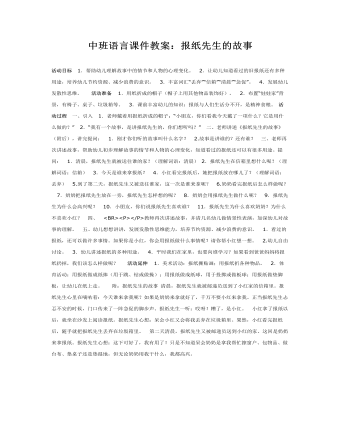
中班语言课件教案:报纸先生的故事
活动准备 1.用纸折成的帽子(帽子上用其他物品装饰好)。 2.布置“娃娃家”背景,有椅子、桌子、垃圾箱等。 3.课前丰富幼儿的知识:报纸与人们生活分不开,是精神食粮。活动过程 一、引入 1.老师戴着用报纸折成的帽子:“小朋友,你们看我今天戴了一项什么?它是用什么做的?” 2.“我有一个故事,是讲报纸先生的,你们想听吗?” 二、老师讲述《报纸先生的故事》(附后),讲完提问: 1.刚才你们听的故事叫什么名字? 2.故事是讲谁的?还有谁? 三、老师再次讲述故事,帮助幼儿初步理解故事的情节和人物的心理变化,知道看过的报纸还可以有很多用途。提问: 1.清晨,报纸先生就被送往谁的家?(理解词语:清晨) 2.报纸先生在信箱里想什么呢?(理解词语:信箱) 3.今天是谁来拿报纸? 4.小红看完报纸后,她把报纸放在哪儿了?(理解词语:丢弃) 5.到了第二天,报纸先生又被送往谁家,这一次是谁来拿呢? 6.奶奶看完报纸后怎么样做呢? 7.奶奶把报纸先生放在一旁,报纸先生怎样想的呢? 8.奶奶会用报纸先生做什么呢? 9.报纸先生为什么会高兴呢? 10.小朋友,你们说报纸先生喜欢谁? 11.报纸先生为什么喜欢奶奶?为什么不喜欢小红? 四、 教师再次讲述故事,并请几名幼儿做情景性表演,加深幼儿对故事的理解。 五、幼儿想想讲讲,发展发散性思维能力,培养节约资源、减少浪费的意识。 1.看过的报纸,还可以做许多事情。如果你是小红,你会用报纸做什么事情呢?请你帮小红想一想。 2.幼儿自由讨论。 3.幼儿讲述报纸的多种用途。
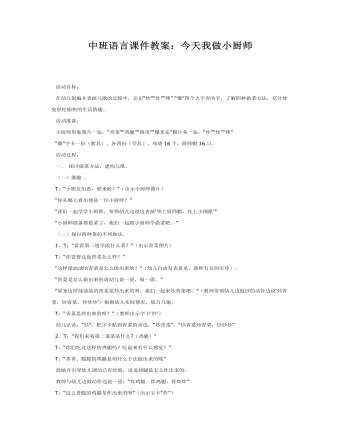
中班语言课件教案:今天我做小厨师
活动准备: 小厨师形象图片一张,“青菜”“鸡腿”“肉串”“爆米花”图片各一张,“炒”“炸”“烤” “爆”字卡一份(教具)、各四份(学具),布袋16个,厨师帽16只。 活动过程: 一、探讨做菜方法,建构儿歌。 (一)激趣。 T:“小朋友们看,谁来啦?”(出示小厨师图片) “你从哪儿看出他是一位小厨师?” “我们一起学学小厨师,带领幼儿边说边表演‘带上厨师帽,挂上小围裙’” “小厨师准备要做菜了,我们一起跟小厨师学做菜吧。” (二)探讨四种菜的不同做法。 1、T:“看看第一道学做什么菜?”(出示青菜图片) T:“你觉得这盘青菜怎么样?” “这样绿油油的青菜是怎么做出来的?”(幼儿自由发表意见,教师有目的引导)。 “青菜是怎么做出来的请幼儿说一说,做一做。” “原来这样绿油油的青菜是炒出来的呀,我们一起来炒青菜吧。”(教师带领幼儿边做炒的动作边说‘炒青菜,炒青菜,炒炒炒’)根据幼儿实际情况,练习几遍。 T:“青菜是炒出来的呀?”(教师出示字卡‘炒’) 幼儿认读:“炒”,把字卡贴到青菜的旁边,“炒青菜”、“炒青菜炒青菜,炒炒炒” 2、T:“我们来看第二道菜是什么?(鸡腿)” T:“你们吃过这样的鸡腿吗?吃起来有什么感觉?”


